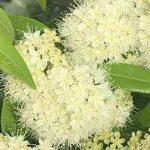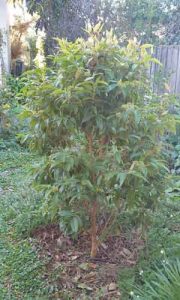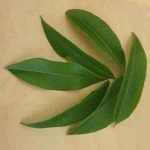 Backhousia citriodora, commonly known as Lemon Myrtle is a great garden addition with its fluffy white to pale yellow, bee-attracting flowers in summer. Also known as Sweet Verbena tree and Lemon Ironwood, its leaves are a source of flavour in food. When crushed, they have an amazing citrus fragrance due to the oil, citral, which is present in high concentration and has health benefits.
Backhousia citriodora, commonly known as Lemon Myrtle is a great garden addition with its fluffy white to pale yellow, bee-attracting flowers in summer. Also known as Sweet Verbena tree and Lemon Ironwood, its leaves are a source of flavour in food. When crushed, they have an amazing citrus fragrance due to the oil, citral, which is present in high concentration and has health benefits.
Position
 This Australian native tree originates from central to south-eastern Queensland in the sub-tropical rainforests. Being quite hardy, it is equally at home in more southern states, if given protection from frosts and cold winds when young. In its natural habitat, it can grow to a height up to 20 metres as a tree. However, it will not reach that height in more southerly areas. Around Sydney it grows as a large shrub to 4 – 6 metres high and around Melbourne it will reach 2 – 4 metres. It can also be grown in a large pot – even indoors.
This Australian native tree originates from central to south-eastern Queensland in the sub-tropical rainforests. Being quite hardy, it is equally at home in more southern states, if given protection from frosts and cold winds when young. In its natural habitat, it can grow to a height up to 20 metres as a tree. However, it will not reach that height in more southerly areas. Around Sydney it grows as a large shrub to 4 – 6 metres high and around Melbourne it will reach 2 – 4 metres. It can also be grown in a large pot – even indoors.
It can be grown as either a hedge or a feature tree. If a hedge, regular pruning is required. If you wish it to be a feature tree, you might like to prune off the lower branches so that the trunk is visible.
Talking Dirty
It tolerates most soils as long as they are well drained and have a pH of 5 – 6. Thorough mulching mimics its native rainforest habitat.
Feeding
Being a slow grower, the addition of manure or slow release organic fertiliser will help promote growth.
Water
Since it is a rainforest tree, it requires adequate water, especially in summer.
Propagation
Take tip cuttings in early autumn or grow from seeds.
Using the Leaves
 Apart from their citral content, the leaves are rich in calcium, other minerals and some vitamins (A, E ad folate) and antioxidants. Before use, they should be washed well. They can be used whole or finely chopped depending on how you plan to use them. If you wish to store them they should be dried – either just by spreading them on a flat surface at room temperature or using a commercial dryer
Apart from their citral content, the leaves are rich in calcium, other minerals and some vitamins (A, E ad folate) and antioxidants. Before use, they should be washed well. They can be used whole or finely chopped depending on how you plan to use them. If you wish to store them they should be dried – either just by spreading them on a flat surface at room temperature or using a commercial dryer
For Health
Citral distilled from the leaves has been used in ointments and creams because of its anti-fungal and anti-microbial properties. It is also used in skincare and haircare products. However, since citral has been implicated in contact dermatitis when used to add fragrance to various products, it might be wise to exercise some caution when using concentrates such as lemon myrtle oil.
Eating
As a bushfood, the most common use of the Lemon Myrtle is for cooking in both savoury and sweet dishes. It can be used to infuse fish, lamb and other meats, as a flavouring in vegetable dishes in the same way you would use bay leaves, drunk as a tea or, when finely chopped, to flavour icecream or yoghurt. You could also use them to olive oil to add a lemon flavour in cooking or salad dressing.
A popular use is Lemon Myrtle biscuits.
Nanna’s Lemon Myrtle Biscuits
Makes: 24
Preparation time: 20 minutes
Cooking time: 12 minutes
Challenge: easy
200g margarine (I prefer to use butter)
100g sugar
100g macadamia nuts (almonds can be used)
225g flour
1 teaspoon baking powder
1 tablespoon lemon myrtle
Cream margarine and sugar until light and fluffy. Add nuts, lemon myrtle, baking powder and flour.
Form little balls (teaspoon sized) and press them flat with a fork.
Bake at 200° C until light brown, approximately 12 minutes.
Recipe originally from www.oztukka.com.au
Related Articles:
Garden Journaling – Slow down to tune in.
As we move through the year and our gardens evolve, there's something magical about documenting the journey. Garden journaling is an art that enables…
The Importance of building soil health for a biodeverse, productive garden
Creating a thriving garden that not only sustains itself but also contributes to the broader ecosystem requires more than just sunlight and water.…




